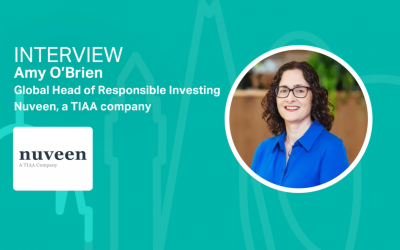Santiago Gowland on Why Regenerative Agriculture is a Business Imperative
Santiago Gowland, CEO of the Rainforest Alliance, spoke to Climate Action following the Climate Innovation Forum during London Climate Action Week. He shared why transforming global food systems is more urgent than ever and how the Rainforest Alliance’s upcoming Regenerative Agriculture Certification Standard aims to drive restoration, resilience, and real impact on the ground.
.png)
Why has transforming how we produce food become so urgent right now?
Climate change, biodiversity loss, and degraded soils are threatening agriculture and rural communities worldwide. With agriculture, forestry, and land use driving nearly 90% of deforestation in tropical regions and contributing 22% of global greenhouse gas emissions, urgent transformation is needed.
Climate action is no longer a moral imperative alone—it’s a business imperative. Climate shocks in major tea, cocoa, coffee, and banana-growing regions already impact prices and availability, and undermine farmer livelihoods. And without bold change, climate change could reduce global agricultural production by up to 35% by 2050, putting critical crops at risk (BCG, 2025).
To survive and thrive, food systems must leapfrog from “do no harm” to “restore and regenerate.” Regenerative agriculture offers a path forward— enhancing biodiversity above and below ground, and supporting climate adaptation and more resilient livelihoods.
The Rainforest Alliance brings together millions of farmers and thousands of companies. How does this broad network help drive real, practical change on the ground?
The Rainforest Alliance is one of the world’s largest and most trusted sustainability certifiers. With nearly four decades of experience, we are one of the key organisations working both with farmers and rural communities and with companies to regenerate land, strengthen livelihoods, and transform supply chains. This makes us a vital partner for companies navigating evolving ESG demands, climate risks, and shifting consumer expectations.
This vast network creates scale, but it also enables learning: a collaborative project in one region can quickly become a global practice. In West Africa, for example, we’ve brought together six major cocoa companies, cooperatives, and communities through our RESTORE initiative. The result: over 20,000 livelihoods improved, 7,700 farmers trained, and tens of thousands of shade trees planted. Change happens when people work together—our role is to help turn shared goals into lasting impact.
You’re preparing to launch a new Regenerative Agriculture Certification Standard in 2025. What makes regenerative agriculture different from traditional sustainability models?
Where traditional sustainability models of “doing less harm”—regenerative agriculture goes beyond this to actively restore the land and communities that sustain us.
At the Rainforest Alliance, our approach to regenerative agriculture is grounded in principles practiced by Indigenous communities for millennia. For example — reducing or eliminating pesticide use, integrating crops with native vegetation and cover crops, composting, and shade management. This helps improve farmer resilience to climate shocks while conserving biodiversity and restoring soil health.
Our new Regenerative Agriculture Certification Standard, launching later this year, is a new, science-based framework co-designed with farmers to go beyond sustainability and support landscape-level restoration. It’s a shift from managing decline to enabling renewal—because the future of food depends not just on protecting nature, but on partnering with it to thrive.
Often, discussions on sustainable agriculture focus on environmental benefits. But how does regenerative farming also support the livelihoods and long-term resilience of smallholder farmers?
Regenerative agriculture isn’t only about restoring soil—it’s about restoring opportunity and resilience for smallholder farmers. By improving soil health, conserving biodiversity, reducing inputs, and diversifying income sources, farmers can build more secure, climate-resilient businesses.
In fact, regenerative agriculture has the potential to raise smallholder coffee farmer income by 62% in some coffee producing regions, increase production and exports by 30%, and cut 3.5 million tonnes of CO2 annually—all while helping restore ecosystems (TechnoServe. 2025).
In Kenya’s Mount Kenya region for example, more than 34,000 farmers have adopted regenerative practices through our MSULLI program, while new farmer-led enterprises have created over 200 local jobs—most held by women and youth.
Farmers are leading this transformation, using regenerative practices like agroforestry to boost productivity and biodiversity. Regeneration isn’t a sacrifice—it’s a strategy for climate resilience, livelihood stability and long-term food security.
We’re seeing more regulations emerge around sustainability claims and supply chain transparency. How can businesses navigate these growing demands while maintaining credibility with consumers?
As regulations around sustainability claims and supply chain transparency grow, businesses face increasing pressure to turn their commitments into impact. Certification remains one of the most effective tools to navigate these demands—it provides traceability, due diligence, and third-party verification that build trust with consumers and regulators. And that trust matters: 72% of consumers say they’re more likely to buy from companies that can prove they are sourcing sustainably (GlobeScan, 2023).
Take for example the EU Deforestation Regulation, which we’ve always strongly supported. Our certification program supports company compliance with the legislation by: providing deforestation risk reports, third party verification, traceability and geodata collection for certified farms, all supported by our robust risk mitigation and assurance system, which is also third party verified. It’s more than just ticking boxes; it’s a platform for continuous improvement and measurable environmental and social change.
As you engaged with leaders during London Climate Action Week, what was the one takeaway you hoped they left with when it comes to regenerative agriculture and business resilience?
If I’m allowed to bend the rules and share not one—but two—takeaways, here’s what I hope leaders walked away with:
- First, that regenerative agriculture isn’t just a nice-to-have — it’s essential for building climate-resilient businesses in a rapidly changing world.
- And second, that transitioning to regenerative agriculture cannot rest on the shoulders of farmers alone. Businesses and investors must step up to close the finance gap, which requires investments in nature-based solutions to triple from current levels to reach $542 billion per year by 2030 (UNEP 2023). By investing in regeneration now, companies can secure their supply chains, adapt to climate risks, and create shared value that lasts.





_400_250_s_c1.png)
